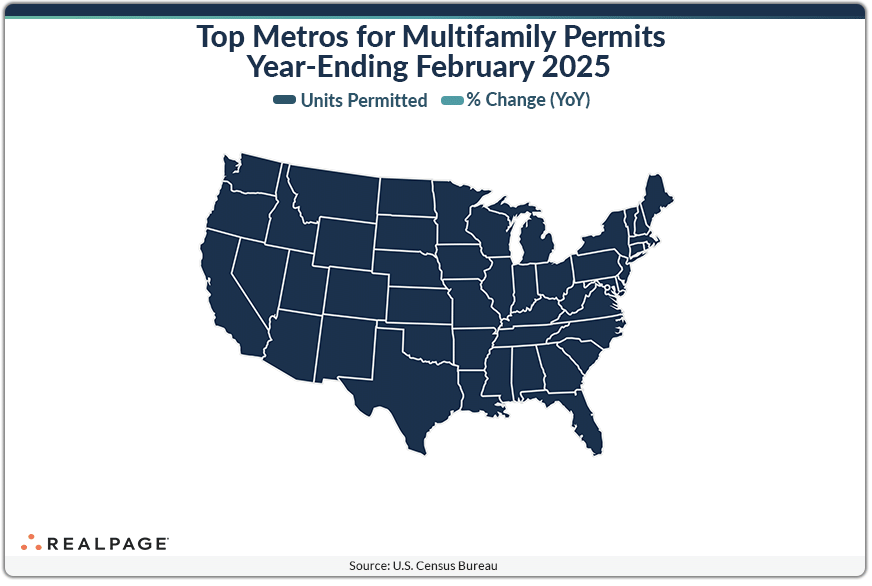As multifamily development slows nationwide, four markets among the top 10 for total multifamily units under construction at the end of 2024 were also on the list for deepest declines in multifamily units permitted for the year-ending February 2025.
Austin and Phoenix saw multifamily permitting drop by about 40% each from last February, while Los Angeles and Washington, DC declined 34% and 23%, respectively. Combined, that’s 23,100 units fewer than the year before in just four markets.
An additional three high supply markets saw permitting fall for the year, but the combined 3,845-unit decrease was minor in comparison. The remaining three high-supply markets actually increased annual permitting from last February by about 6,500 units, led by New York’s increase of 4,332 units.
Other metros with significant declines in multifamily permitting include markets that have had recent oversupply concerns such as Jacksonville, Nashville and Raleigh/Durham.
Turning to this month’s top permitting performers, nine of last month’s top 10 permitting markets returned on February’s list. New York continues to lead the nation for multifamily permits with the aforementioned 4,332-unit annual increase to 31,534 units (although, the Big Apple had a month-over-month decrease of almost 5,100 units from January’s annual figure).

Dallas, Atlanta, Austin and Houston remained in the top five with annual permitting in the 12,000 to 14,000-unit range. Orlando and Tampa had modest increases in annual permitting to stay in the top 10, while Phoenix, Washington, DC, and Los Angeles made the deepest declines list above.
In addition to New York and Atlanta, other markets with significant year-over-year increases in annual multifamily permitting in the year-ending February were Fort Worth (+2,879 units), Chicago (+2,410 units), Omaha (+1,796 units), Milwaukee (+1,585 units), Baltimore (+1,318 units) and Anaheim (+1,307 units).
Beyond the list of top markets with significant declines in multifamily permitting, other declining markets include Miami (-2,678 units), San Antonio (-2,643 units), Salt Lake City (-2,518 units), San Jose (-2,316 units) and Indianapolis (-2,122 units). Eleven other markets had decreases in permitting of 1,000 units or more.
Below the metro level, nine of last month’s top 10 permit-issuing places returned to this month’s list with only two remaining in the same place. The list of top individual permitting places (cities, towns, boroughs and unincorporated counties) generally include the principal city of some of the most active metro areas.
The borough of Brooklyn remained the top permitting spot in February, but sister borough Bronx slipped to #3 behind the city of Atlanta. Charlotte’s Mecklenburg County moved up two spots to #4, although their annual permitting was little changed from January’s total. The city of Los Angeles also remained in its previous spot at #5.
The city of Fort Worth moved up one spot and the city of Miami climbed three spots, while the city of Austin tumbled four spots to #8 with a decrease of more than 1,400 permitted units from last month. The city of San Diego inched up one spot to #9 and the city of Columbus made the top 10 with 4,738 units permitted, displacing the Queens borough from this month’s list.
This post is part of a series by RealPage Senior Real Estate Economist Chuck Ehmann analyzing residential permits and starts data from the U.S. Census Bureau. For more on this data, read previous posts in the Permits series.










